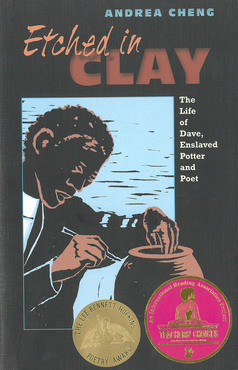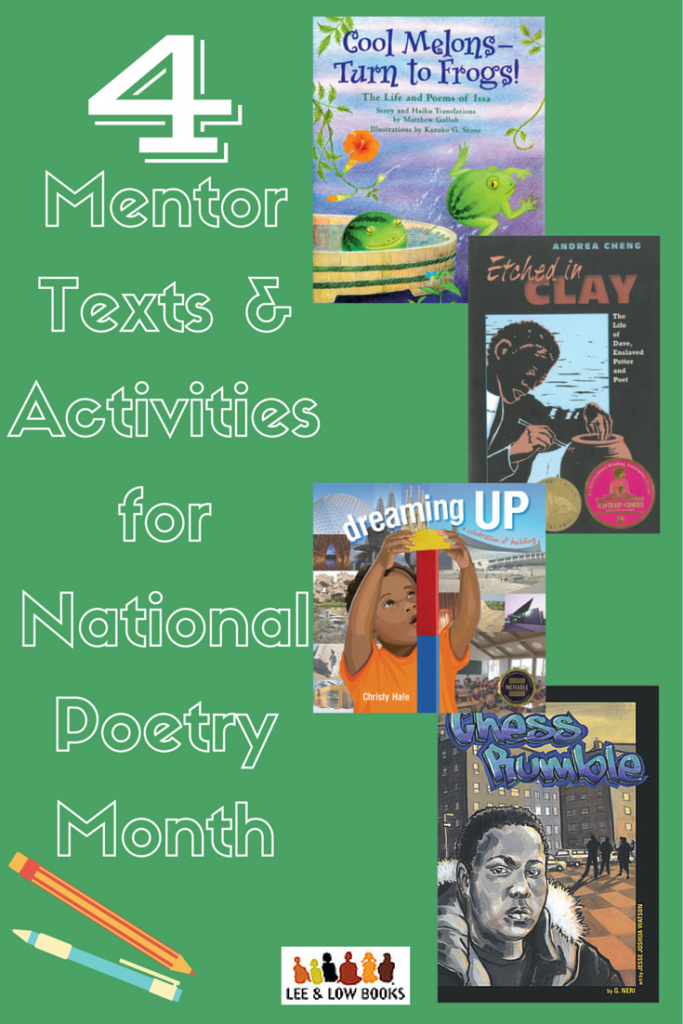April is National Poetry Month. With so many forms of poetry to explore and share with students, what will you choose?
Here are 4 ideas for using mentor texts to guide students in poetry study.
Additional bonus: a letter to teachers from author and poet, Pat Mora, on the power of poetry.
Mentor Text: Etched in Clay: The Life of Dave, Enslaved Potter and Poet
 Activity with students: Students select words and phrases from a primary text and use those words to create their own unique poems.
Activity with students: Students select words and phrases from a primary text and use those words to create their own unique poems.
As “Primary Sources + Found Poetry = Celebrate Poetry Month” suggests, the Library of Congress proposes an innovative way to combine poetry and nonfiction. Teaching With The Library of Congress recently re-posted the Found Poetry Primary Source Set that “supports students in honing their reading and historical comprehension skills by creating poetry based upon informational text and images.” Students will study primary source documents, pull words and phrases that show the central idea, and then use those pieces to create their own poems.
This project not only enables teachers to identify whether a student grasps a central idea of a text, but also encourages students to interact with primary sources in much the same way as Etched In Clay’s Andrea Cheng. When researching Dave’s life and drawing inspiration for her verses, Andrea Cheng integrated the small pieces of evidence of Dave’s life, including poems on his pots and the bills of sale.
Poem type: HAIKU
Mentor Text: Cool Melons—Turn to Frogs! The Life and Poems of Issa
 Activity with students: Students write haiku using sensory language and drawing inspiration from body movement, music, and art to create their own haiku.
Activity with students: Students write haiku using sensory language and drawing inspiration from body movement, music, and art to create their own haiku.
Check out the classroom-tested, standards-aligned lesson plan Experiencing Haiku Through Mindfulness, Movement & Music by Rashna Wadia with Cool Melons— Turn to Frogs! provided by ReadWriteThink.org, a website developed by the International Literacy Association and the National Council of Teachers of English.
Additional resources:
- Explore 4 Haiku-Sparking Activities with your students created by Cool Melons-Turn to Frogs! author Matthew Gollub.
- What is a haiku? from author Matthew Gollub of Cool Melons—Turn to Frogs! The Life and Poems of Issa
Poem type: CONCRETE OR SHAPE POETRY
Mentor Text: Dreaming Up: A Celebration of Building
 Activity with students: Students choose a building to describe in a poem and shape the poem to look like the building.
Activity with students: Students choose a building to describe in a poem and shape the poem to look like the building.
In Reading is Fundamental’s educator activity guide for, Dreaming Up, encourage students to try the writing activity “Shape It Up:” Let students pick a type of building and write a poem describing that building (how it looks, its purpose, etc). Students should write their poems on white paper in the shape of the building and decorate the background. (RIF)
Poem type: NARRATIVE POETRY
Mentor Text: Chess Rumble
 Activity with students: Students compare narrative and lyric poetry and write their own narrative poem based on real or imagined experiences or events.
Activity with students: Students compare narrative and lyric poetry and write their own narrative poem based on real or imagined experiences or events.
Check out the research-based novel study unit for Chess Rumble created by the staff at the award-winning, non-profit ReadWorks.org. Students will compare the story elements of Chess Rumble to Where the Sidewalk Ends and Keeping the Night Watch.
Next, students write their unique narrative poem—for tips “by youth for youth” check out How to Write a Narrative Poem from Power Poetry.
Further reading on using poetry in the classroom:
- Brisk and Bright Approaches for National Poetry Month from Edutopia
- Integrating Daily Poetry in the Classroom: 5 Tools to Support Your Efforts from Edutopia
- Poetry 180 Project from the Library of Congress and former Poet Laureate Billy Collins
What are your favorite poems to enjoy in the classroom? Share with us!
Jill Eisenberg, our Senior Literacy Expert, began her career teaching English as a Foreign Language to second through sixth graders in Yilan, Taiwan as a Fulbright Fellow. She went on to become a literacy teacher for third grade in San Jose, CA as a Teach for America corps member. She is certified in Project Glad instruction to promote English language acquisition and academic achievement. In her column she offers teaching and literacy tips for educators.



One thought on “4 Mentor Texts and Activities for National Poetry Month”
Comments are closed.